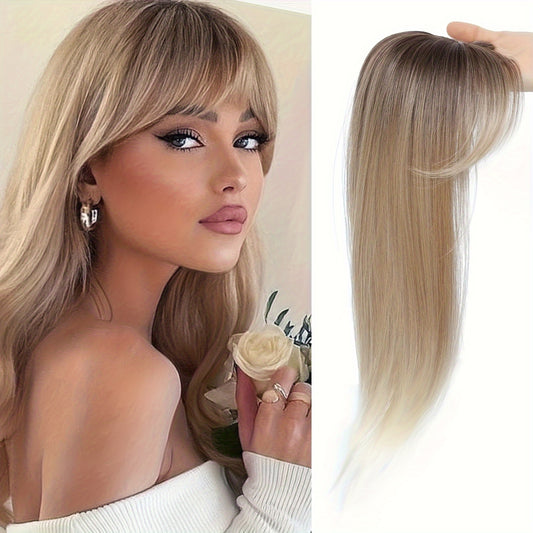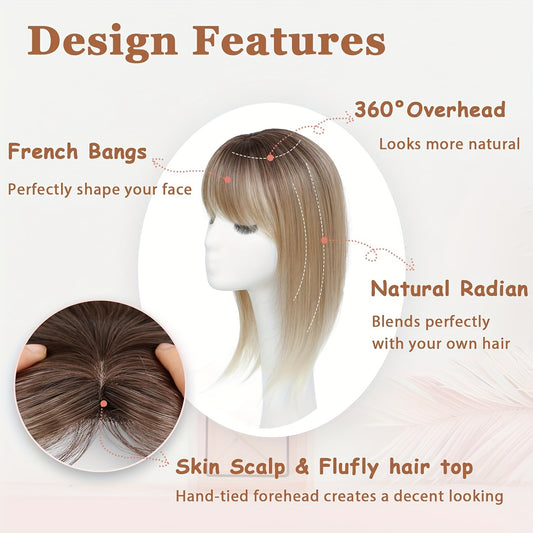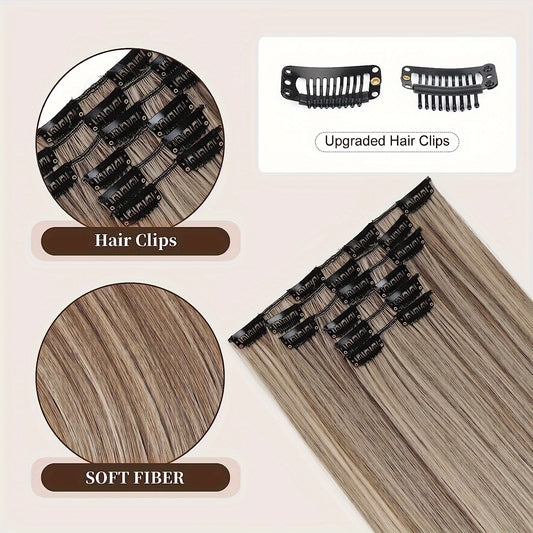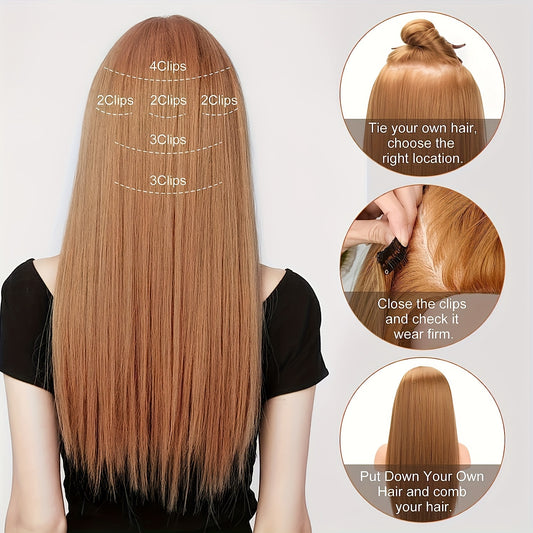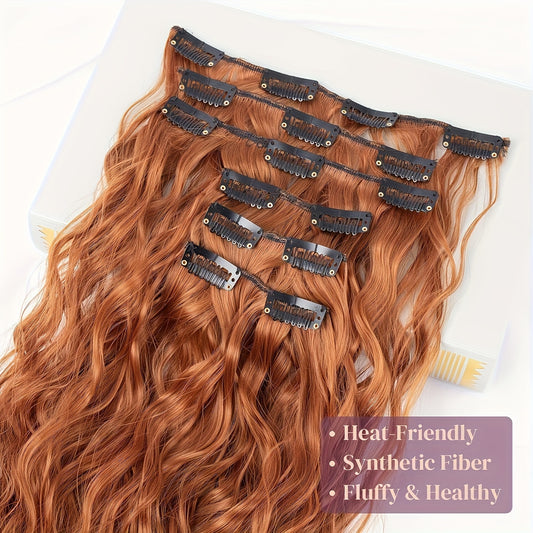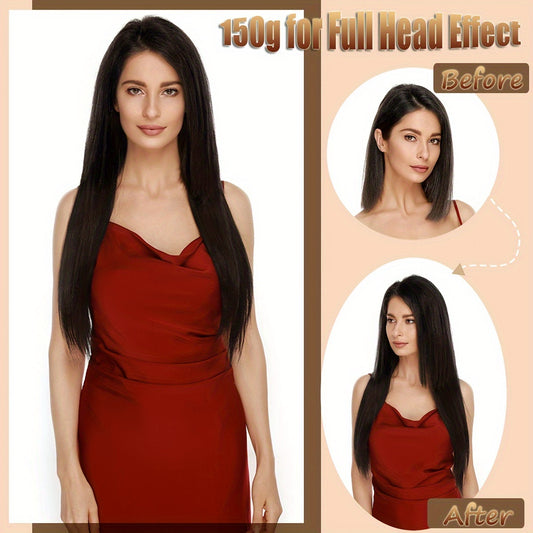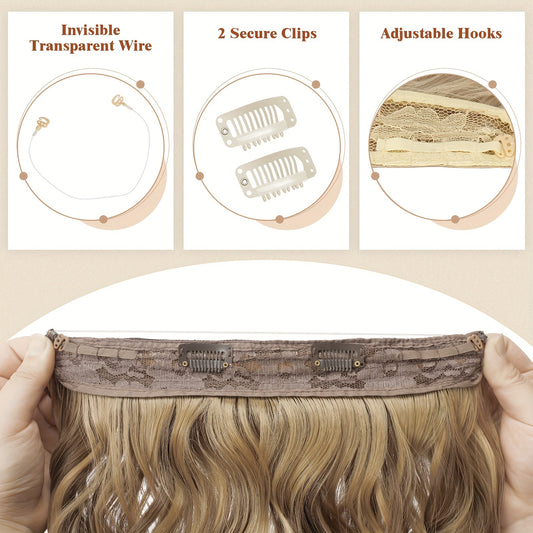About Light Chestnut Brown Hair Extensions
Light chestnut brown is the feel-good shade people describe as “sun in a mug”: warm without tipping orange, rich without going dark, and easy to style for office days, weekends, and events. This guide mixes practical steps with a little friendly commentary, so you can choose extensions with confidence, style faster, and keep your finish consistent in everyday light.
Light chestnut brown explained
On the brunette spectrum, light chestnut brown sits between classic medium brown and soft caramel. It carries a quiet golden warmth under daylight, a honey edge in late afternoon, and a cozy depth under warm indoor lamps. The key to making the shade look natural is balance—keeping warmth present but refined so it never drifts into brass. Extensions in this tone blend widely because many natural brunettes lift toward chestnut during the year; that built-in familiarity helps the join look seamless.
Where the shade lives and why it flatters
Chestnut belongs to the mid-light zone of brown, which is why it brightens faces without the stark contrast you see with dark brunette or black. It works on neutral, warm, and many cool skin tones when you fine-tune undertone. If your wardrobe leans cream, tan, olive, and denim, chestnut reads “designed” instead of “added.” If you wear monochrome black, chestnut softens the look and adds dimension on camera. Because the value is moderate, it tends to flatter a broad age range and adapts across seasons.
Undertone choices made simple
Think of undertone as the direction your chestnut leans. Neutral chestnut stays steady in mixed light. Golden chestnut glows near cream sweaters and tan trenches. Mocha-chestnut skews a hint cooler so it resists orange cast under restaurant bulbs. Caramel-chestnut adds a honey note that photographs beautifully at golden hour. Pick the undertone for the rooms and outfits you use most—your mirror matters more than the store lights.
Texture mapping for realism
Straight chestnut looks tailored and glossy when you add a micro bevel at the ends so the hem doesn’t read like a line. Body wave hides joins and brings movement that feels effortless in day-to-day wear. Loose curls add lift and frame the jawline softly. Coily textures look authentic when the coil size echoes your natural pattern; the shade then reads as your hair on its best day rather than a separate piece. Choose the texture that matches both your styling patience and your base hair behavior.
Length planning by landmarks
Numbers become easier when you tie them to visible landmarks. Fourteen inches grazes the collar on many frames, sixteen sits at upper shoulder, eighteen at mid shoulder, twenty at upper back, twenty-two around mid back, and twenty-four at lower back. Wave or curl shortens the visual slightly because of pattern, while straight reads the longest. If you’re between choices, order a touch longer and plan for a small trim so your hem lands exactly where your eye wants it.
Grams and density without the guesswork
Grams control visual weight and comfort. Lighter daily builds often feel calm around ninety to one hundred twenty grams. Everyday fullness typically lives between one hundred twenty and one hundred fifty grams. Event builds can climb toward one hundred sixty to two hundred grams if your base remains comfortable and your install distributes weight well. Match hem density to your crown density so the head reads as a single design; if your crown is fine, wave patterns create volume with fewer grams.
Attachment formats at a glance
Clip-ins change density quickly, remove at home, and suit people who like control over daily styling. Seamless clip-ins hide the edge under finer hair because the band lies flatter. Tape-ins spread weight across small panels for a smooth base that follows salon cycles. Wefts (hand-tied or flat) create structured rows when you and your stylist want long-wear control. One-piece volumizers lift the crown in five minutes when you need a fast refresh for calls or dinners.
Clip-ins for flexible days
Clip-ins shine when your schedule varies. You can add a row for meetings, remove it for the gym, and reinstall for dinner. Set anchors on clean, dry roots, angle the teeth slightly downward, and test with a slow head turn to confirm zero slip. Stagger widths so tops don’t stack, and leave a finger’s width near the hairline; your profile will thank you in photos.
Seamless clip-ins for finer bases
If your natural hair is delicate at the crown, seamless clip-ins reduce visible bulk. The flatter band spreads tension and sits closer to the head, which helps chestnut’s light play read smooth instead of layered. Keep your lowest row above collar height to prevent rubbing from jackets, and brush in the direction you intend to wear the hair to avoid cross marks.
Tape-ins when you want set-and-forget
Tape-ins suit tidy routines. Panels sit flat, grow out evenly, and follow a predictable move-up calendar. Keep oils away from bonds, dry roots completely, and sleep with a loose braid so friction stays low. If you film often under bright office LEDs, tape-ins’ flat base helps chestnut read like your own hair from the side and in motion.
Wefts for structured silhouettes
Wefts concentrate hair along rows, which makes silhouettes clean and repeatable—great for polished looks, content shoots, and event seasons. Even tension and neat fold-backs keep edges quiet on camera. If your wardrobe includes sharp blazers or tailored coats, a weft build with straight or soft wave texture can make your outline look curated with very little daily effort.
One-piece volumizers for quick lift
A single volumizer can change your day. Pop it in after lunch, brush once, and your crown looks refreshed. If your morning blow-dry drops by 3 p.m., a light chestnut one-piece returns profile lift without a full restyle. For small heads or sensitive roots, choose a lighter gram option and rely on texture for volume.
Why light control matters
Chestnut reacts to light like a friendly mirror. Daylight reveals gold and honey micro tones, office strips cool the shade down, and evening lamps add glow. Clean your phone lens, lock white balance where possible, and keep shooting distance steady; those three tiny habits stop undertone from drifting across posts and make your extensions look “real life” instead of “edited.”
Finish and shine that look expensive
Aim for satin: not mirror-gloss, not mattified. Shape with one slow pass at low to medium heat, let the hair cool fully, then brush once to merge strands. Heavy gloss sprays can flatten texture in mid-light browns, while matte powders can create a dusty cast that photographs dull. Satin finish preserves chestnut’s dimensional strands, so movement stays visible.
Face shape and silhouette harmony
Round faces often shine with body wave and slightly longer lengths below the collar. Oval faces accept most patterns and lengths. Square faces soften with loose curls and a beveled hem. Heart faces balance with mid mounts and a line that passes the collarbone cleanly. Treat hair and clothing as one silhouette: straight hems complement tailored jackets; waves soften draped knitwear; curls create lift above simple necklines.
Wardrobe pairing that always works
Light chestnut brown loves cream, bone, oatmeal, navy, denim, olive, camel, and soft blush. Optical white turns contrast up to maximum for crisp photos; bone delivers a gentler, editorial look. Silver jewelry emphasizes mocha-leaning chestnut, while gold jewelry harmonizes with caramel-leaning chestnut. If an outfit skews warm and you lose separation in photos, add a white tee or scarf near the face to reset the visual edge.
Makeup alignment for the shade
Ash-leaning chestnut pairs nicely with taupe brows, soft plum or charcoal liners, and berry or rose lips. Golden-leaning chestnut welcomes warm brown liners, soft gold lids, and brick or cocoa lip tones. Keep bronzer soft at the hairline under cool LEDs to prevent an orange halo that makes the shade read off.
Workday routine that holds up
Set mounts to mid for headset clearance and jacket changes, keep grams moderate, and choose straight with a soft bevel or a modest body wave. Avoid oils at the base so anchors and bonds stay firm. Carry a tiny brush and two pins. Before a big meeting, capture one profile still to confirm seam quiet; if you see a shelf, adjust placement rather than layering product.
Event routine with polish
Decide on necklines first, then set mid or high mounts to complement them. Increase grams only if comfort remains after a small jump test. Polish with a slow heat pass, cool fully, brush once, and review a quick still under venue lighting. A tiny micro trim the week before an event makes hems look custom, especially in straight and soft wave patterns.
Gym and commute considerations
For the gym, coil hair forward and secure loosely; sweat plus elastic pressure can imprint the nape if you keep hair against a high seat back. On trains and rideshares, sit slightly forward to avoid constant hem friction. After a windy walk, step indoors, detangle from ends, re-press seams, and do a single wide-tooth pass—skip heat so pattern memory stays intact.
Care and wash schedule you can keep
Wash when hair feels coated, not on a rigid day count. Use cool water and a gentle shampoo. Keep bond zones dry if your method requires it. Condition mid-lengths to ends, rinse until water runs clear, blot gently, and air-dry flat so the outline holds. Detangle dry, braid loosely for storage, and label pouches with length, grams, texture, undertone, and last trim date so redeployments take seconds.
Heat styling with patience
The set happens on the cool, not on the pass. One slow pass, clips to hold curls while they cool, then a single brush to merge. Avoid clamping heat across seams; mechanical integrity sells realism more than shine ever will. If you lean curl, clip each section in its natural fall and let room temperature return before touching.
Color consistency across phones
Different phones shift reds and yellows differently. That matters in chestnut because warmth is the star. Test on your device and a friend’s, then standardize your posting workflow to one phone. Lock white balance and reuse your favorite room so the shade reads the same from Monday to Sunday.
Photo workflow for busy creators
Mark a floor position with tape, save a reference frame showing exposure and distance, and shoot at the same time of day. Light chestnut brown will look identical across reels if the inputs stay the same. If something looks off, fix room, angle, or distance before changing hair—most color issues are optics first.
Travel packing that prevents stress
Carry a soft brush, two pins, a gentle cleanser decant, and a small pouch. On planes and trains, bring hair forward and leave a gap from the seat back. In hotel rooms, use a window as your key light and a pale wall as bounce. A quick profile still at check-in tells you how the room treats undertone so you can adapt.
Longevity and budget math
Extensions reduce dye cycles on your own hair, which lowers heat and chemical exposure over time. A smart rotation—lighter daily set and a slightly heavier event set—spreads wear across seams and keeps attachments feeling fresh. Micro trims keep hems crisp; early hardware fixes stay invisible. Small, consistent maintenance beats occasional overhauls for both budget and finish.
Sustainability and care choices
Lower heat, fewer products, and calm handling are better for hair and the planet. Air-dry when you can. Choose gentle cleansers and avoid over-washing. Rotate sets so you’re not overbuilding density on one base. These habits also make chestnut’s surface look more expensive because strands lie calmer when they’re not oversaturated with product.
Quality checklist before you buy
Confirm length, grams, texture, and stitching quality in base photos. Ask for daylight shots of base and hem, plus a side profile to judge seam quiet. If store images look overly warm or cool, request a neutral daylight reference. Save those references; they will help you reorder confidently when you find your perfect match.
Partnering with a stylist
Bring a snapshot of your main room, a few wardrobe staples, and your target inches. Agree on gram targets, undertone, and a trim plan. Chestnut’s light-friendly nature means small changes at the hem or mount height can make you look newly polished with no extra product. Share your maintenance habits honestly; your stylist can engineer comfort and realism that fit your real week.
Troubleshooting seams and shelves
If a line prints in profile, the fix is mechanical. Stagger tops so they don’t stack, adjust angles slightly downward, and space rows evenly. If a tape sits too close to the hairline, move it deeper rather than adding sprays. In wefts, keep fold-backs neat and flat; ironed fold-backs can print under bright lights, while finger-pressed, cool fold-backs disappear.
Troubleshooting undertone shifts
If chestnut looks too red in warm lamps, move toward mocha-leaning chestnut or shoot in a cooler room. If it looks dull under cool LEDs, lean golden or caramel and introduce a soft side light. Lock white balance on your phone, clean the lens, and keep distance consistent; those three steps solve most undertone drift.
Fixing dryness or frizz before it starts
Brush in the direction you plan to wear the hair and stop if you feel resistance; forcing a pass creates micro frizz that cameras emphasize. Hydrate mid-lengths and ends, keep bases dry, and avoid stacking products on day two or three—build-up dulls chestnut’s strand detail and makes light scatter unevenly.
Humidity and summer workflow
Humidity softens straight lines, so lean into body wave or loose curls on high-moisture days. Clip each section to cool fully before brushing; the pattern will relax into smooth movement rather than collapsing. Carry a soft scrunchie for outdoor stretches, coil hair forward, and release indoors to restore alignment.
Cold weather and static control
Winter air lifts flyaways and increases friction against coats. Keep your lowest row above collar contact, mist water lightly before brushing, and give the panel thirty seconds to settle before moving. Rounded coat collars glide; sharp points can catch hems. Match collar shapes to mount height to avoid persistent scuffing.
Edge health and daily comfort
Rotate mount heights across the week, keep tension firm but not tight, and drop grams if edges feel stressed on long days. A comfortable base disappears from awareness, which is why it looks natural on video—it isn’t fighting your movements. Comfort is a style choice, not just a feeling.
Storage and rotation for real life
Detangle dry, braid loosely, cushion with acid-free tissue, and store flat in a breathable pouch. Label each set with length, grams, texture, undertone, and last trim date. If an event set sits for months, schedule a quick review before the season starts; tiny adjustments now keep the finish sharp later.
Common myths to ignore
Myth: more gloss equals better hair. Truth: chestnut needs controlled sheen, not mirror shine. Myth: more grams always look fuller. Truth: volume without balance reads heavy and artificial. Myth: cameras fix everything. Truth: cameras exaggerate both wins and mistakes; good optics and clean mechanics win every time.
Small tutorials that pay off
Micro bevel: take a tiny angle off the hem with scissors pointed vertically; that whisper of curve sells natural movement in straight styles. Body wave: large sections, one slow pass, clip to cool, brush once. Loose curl set: medium sections, wrap away from the face, let room temperature return, then comb lightly with fingers so the pattern breathes.
Everyday looks that love chestnut
Soft low pony with a wrap strand looks chic in minutes. Half-up with two pins gives lift without teasing. A loose side braid shows color ribbons and keeps hair out of your collar on long drives. If you film, choose one of these as your default and vary accessories; your followers will recognize the silhouette even as outfits change.
Why confidence matters
When your routine becomes a short, repeatable sequence, you stop thinking about hair and start thinking about the day. Light chestnut brown rewards calm decisions: pick undertone for your rooms, choose a length that hits a landmark you love, keep grams aligned to your crown, and use simple optics habits. The result reads intentional, current, and personal—no heavy styling required.
How to choose from the collection
Start with inches and undertone, then decide format based on lifestyle. If you like quick change, clip-ins or seamless clip-ins keep mornings flexible. If you want flat, low-maintenance cycles, tape-ins make sense. If you prefer a tailored silhouette and stylist support, wefts are the steady choice. Revisit grams only after you’ve seen a profile still in your main room; mechanics before product keeps choices simple.
Planning your first week
Day one: install or apply, capture a daylight still, and note undertone. Day two: repeat the same room and distance to confirm consistency. Day three: try body wave or a micro bevel and take a profile photo. Day four: commute test—jacket on and off. Day five: a quick dinner look with a low pony or half-up. Keeping the week structured proves your decisions quickly without overwhelm.
Confidence in ordering
Clarity beats impulse when you’re adding a new tone. Confirm the three non-negotiables—undertone, inches, and grams—and decide format based on comfort. Save your notes in the pouch. When you reorder, you’ll know exactly which settings created your “looks like me” chestnut instead of starting from scratch.
Where the brand helps
Fabulive lists length ladders, gram ranges, and texture options in simple language so you can decide faster and order once with confidence. Fabulive’s shade tiles show chestnut undertones in daylight from front and side views, which makes it easier to choose between neutral, golden, caramel-leaning, or mocha-leaning finishes for your real rooms. When inches must match results, Fabulive provides close hem shots and side profiles so you can predict edge clarity before the box arrives. For care basics, Fabulive posts a clean, short wash routine plus a clear reminder to keep bond zones product-free if your format requires it. If you want rooted or balayage chestnut options, Fabulive’s product pages place root depth next to mid and end tones so you can picture the join clearly before you check out.
Creator notes for consistent content
Choose one room, one light position, and one lens distance and reuse them. Note part direction and sweep direction; reel continuity improves when motion repeats. Post from the same device where you tested undertone and keep exposure locked. If tone drifts, change the room or angle first; only change hair when optics are already right.
Micro decisions that save time
Write your fixed inputs—mount height, grams, length, texture, undertone—on a small card and keep it in the pouch. Update only when a change feels better three days in a row. That small habit keeps your chestnut finish deliberate across busy weeks and stops panic edits before a meeting or dinner.
When to trim and why it matters
Factory hems can read blunt. A micro trim after install joins ends to your cut and closes small gaps that cameras exaggerate. In wave and curl patterns, that trim keeps the shape generous without stacking weight. If you aim for straight, a beveled hem keeps the line lively and helps chestnut catch light softly instead of reflecting as a hard stripe.
Optical separation from your background
If hair and background both look mid or dark, step forward half a meter and turn slightly from square. A gentle rim light appears along the edge, separating outline from clothing or wall. That small move keeps chestnut’s dimension visible and makes your profile look professional without filters.
What to skip
Skip oils near anchors and bonds, skip last-minute heat passes on a fully cooled set, and skip stacking sprays to hide mechanics. Skipping these saves time and preserves chestnut’s strand detail, which is the real cue people read as quality. Calm surfaces photograph better than coated surfaces.
Your go-to checklist
Clean lens. Lock white balance. Choose one room. Check a profile still. Confirm seam quiet. Brush once after full cool. If anything looks off, adjust room, angle, or distance before touching the hair. With this checklist, light chestnut brown stays believable in every setting—from office LEDs to late-night portraits.
Customer reviews
-
The neutral chestnut matched my grown-out balayage better than I expected; a single brush after full cool kept the finish calm on a long office day. — Hannah Cooper, USA ⭐⭐⭐⭐⭐
-
I wear cream knits and tan coats; the golden-leaning chestnut looks intentional, not “add-on,” and the hem sits perfectly after a tiny trim. — Charlotte Reed, United Kingdom ⭐⭐⭐⭐⭐
-
Delivery took an extra day but the set is excellent; undertone stays steady under studio LEDs and evening lamps. — Finn Müller, Germany ⭐⭐⭐⭐
-
Swapped between clip-ins for weekdays and a one-piece for quick dinners; the shade blends with my natural roots even in bright elevators. — Ava Thompson, Canada ⭐⭐⭐⭐⭐
-
I film cooking videos in a small kitchen with warm bulbs; locking white balance made the caramel note read consistent across reels. — Isabella Rossi, Italy ⭐⭐⭐⭐⭐
-
Gorgeous movement and easy styling, though I wish I had ordered a few more grams; still, the wave pattern hides joins nicely. — Oliver Bennett, Australia ⭐⭐⭐⭐
-
My hair is fine and the seamless band stays flat; light chestnut brightens my face without needing much makeup. — Sofia García, Spain ⭐⭐⭐⭐⭐
-
First extensions for me; the small settings card idea helped me repeat a good day three times in a row. — Mia Andersen, Denmark ⭐⭐⭐⭐⭐
-
I shoot on two phones and noticed color drift; posting from one device fixed it and the chestnut tone looks true now. — Ethan Clarke, New Zealand ⭐⭐⭐⭐⭐
-
Comfortable, natural, and easy to store; I’d only expand the pickup window locally. The shade reads soft and expensive in daylight. — Amélie Dubois, France ⭐⭐⭐⭐

